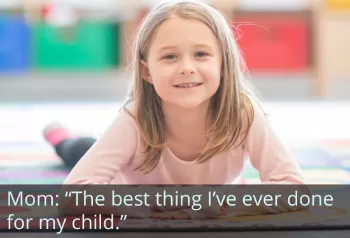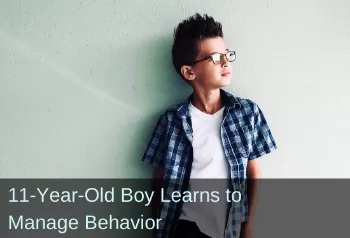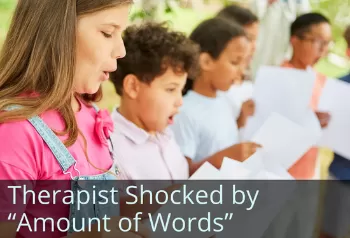Sonia’s Insights: Deep Dive into Development
How to Tame Meltdowns and Manage Transitions
Dr. Blomberg’s #1 Recommendation For Tantrums, Meltdowns, and Troublesome Transitions
What is at the root of emotional and behavior disturbances? How can we prevent meltdowns and address challenging transitions?
by Sonia Story, M.S.
To answer these questions let’s start with what we know about toddlers, explore the observations of Harald Blomberg, MD, and connect it all to supporting research. Then we will take a look at some inspiring and highly consistent results that validate Dr. Blomberg’s #1 recommendation for turning around problematic behaviors.
Parents throughout the ages have noticed that toddlers often misbehave. As long as the incidences are not too often or too severe, it is considered normal for a toddler to have unreasonable demands, challenging transitions, or occasional screaming tantrums.
However, sometimes a toddler cannot be soothed or redirected during an outburst—even when we acknowledge their feelings, or offer comfort. A tantrum can then escalate to a “meltdown” and go on for a very long, stressful time. Unfortunately, it is not just toddlers who have meltdowns. A child or teen can get stuck in toddler-like behaviors—not because they are willfully misbehaving, but because they do not have the brain connectivity, or the sensory maturity, to act differently. This adversely affects nearly all aspects of life, and diminishes a child’s self-esteem. The older the child becomes without resolution, the harder it is for everyone involved.
While parenting strategies can help, the underlying issue is in the neuro-sensory-motor systems. Dr. Blomberg worked with many children and adults with emotional and behavioral disorders in his psychiatric practice. In one of his courses, I remember him saying: “The main emotional problem of children today is that they haven’t moved enough.” He was talking about the fact that children with emotional and behavioral challenges most likely did not receive enough innate rhythmic and reflex movements in early childhood to have the brain, body, and sensory maturity necessary to manage their emotions in more mature and age-appropriate ways. In other words, the lack of these innate movements in infancy causes deficits in physical, social-emotional, and cognitive functioning that can hinder a child’s ability to mature properly, resulting in emotional and behavioral challenges later on. Most parents and professionals intuitively sense that meltdowns and outbursts are rooted in extreme anxiety and discomfort—so what is the origin of the anxiety and discomfort?
Top 5 Root Causes of Anxiety and Discomfort in Children with Behavioral Challenges
To understand where the extreme anxiety and discomfort come from, and why they are often at the root of misbehavior, let’s look at what happens when an infant develops without fully engaging in a complete repertoire of innate movements, or when these innate movements have been hindered via trauma, illness, or injury. Here is my understanding of the top 5 most likely root causes of anxiety and discomfort:
- Fight, Flight, or Freeze States. When there has been a lack of innate movements in infancy, unintegrated reflexes are often present. This can leave the child’s nervous system in near constant states of fight, flight, or freeze. These more primitive nervous system states make it very challenging for the child to be self-regulated and emotionally mature. The child is more likely to be volatile and reactive.
- Hypersensitivities. When primitive reflexes are unintegrated, issues with sensory processing and hypersensitivity to sensory stimulation are common (Goddard-Blythe, 2023; Pecuch et al., 2020). A child is more likely to feel uncomfortable, agitated, irritable, anxious, or depressed, and to exhibit social-emotional and behavioral challenges (Ben-Sasson et al., 2009). Researchers have found that “sensory over-responsivity”—experiencing sensations more intensely and for longer durations than is normal—leads to fight or flight states and is likely a causal factor in the development of anxiety (Lane & Reynolds, 2019). Children with ASD had elevated anxiety compared to non-ASD children (van Steensel & Heeman, 2017), and sensory over-responsivity was a mediating factor between autistic traits and anxiety (Amos et al., 2019).
- Poor Balance. Along with the innate rhythmic movements, the infant reflexes are key for the development of our vestibular system and our postural control and ability to balance. When primitive reflexes are unintegrated, children are far more likely to have poor balance. Proper physical balance seems to be necessary for emotional balance and wellbeing, while poor balance is associated with anxiety. This is especially significant because researchers have linked balance deficits to both ADHD (Konicarova et al., 2014) and to autism spectrum disorders (Oster & Zhou, 2022; Kohen-Raz, 1992). Confirming Dr. Blomberg’s observations (see below), researchers found that sensory-motor programs to improve balance helped reduce anxiety and increase self-esteem in children (Bart et al., 2009). Other promising research shows integrating primitive reflexes is associated with better balance (Infante-Cañete et al., 2023; Jeong et al., 2021, Grzywniak, 2017) and vestibular development (Stephens-Sarlós, 2024). Innate rhythmic movements were linked to improvements in balance, coordination, and reading in dyslexic children (Pérez-Rey et al., 2024).
- Inability to Communicate. It stands to reason that anyone who is unable to communicate might have heightened anxiety. We can easily sense anxiety in our interactions with autistic non-speakers and we know that anxiety is common in autistic individuals (Riis et al., 2025; van Steensel & Heeman, 2017). Communication is a survival skill that begins developing in infancy. Like nearly every skill, speech is dependent on the foundation laid down in large measure by the rhythmic movements (Iverson, 2009) and by the primitive reflexes. When primitive reflexes are unintegrated, it is associated with developmental communication disorders (Matuszkiewicz & Gałkowski, 2021) and social and language impairments (McPhillips et al., 2014).
- Poor Visual Tracking Skills. Did you know that poor visual tracking goes hand-in-hand with anxious states? This is something I learned from Bill Hubert, developer of Bal-A-Vis-X, and it makes so much sense. If visual tracking is poor, we cannot easily process visual input. Imagine how disconcerting or scary that could feel. We know from research that visual skills deficits are strongly linked with retained primitive reflexes (Domingo-Sanz, 2024; Domingo-Sanz, 2022; Andrich et al., 2018; Gonzales et al., 2008). And there is a remedy: Using movements to integrate primitive reflexes is associated with significant improvements in visual skills (Domingo-Sanz, 2024; Domingo-Sanz, 2022). Because we rely so much upon our vision, improvement in this area could lead to better functioning and reduced anxiety.
Dr. Blomberg’s #1 Recommendation
When we consider the above 5 challenges, all roads point to immaturity of the neuro-sensory-motor systems as the basic issue underlying meltdowns and trouble with transitions.
Innate infant movements are the foundational neurodevelopmental movements that Dr. Blomberg and many others have found to be crucial to our ability to function well. To mitigate the anxiety and discomfort and foster better behavior, Dr. Blomberg’s #1 recommendation is to consistently give the child neurodevelopmental movements—both rhythmic movements and reflex integration movements. Many therapists already know the importance of primitive and postural reflex integration, but the innate rhythmic movements are just as vital because they build the brain, body, and sensory systems. They are especially soothing and organizing for the nervous system. Some parents have even reported that these rhythmic movements stopped meltdowns right in the moment as well as provided long-term relief with greatly reduced incidences. Dr. Bruce Perry, psychiatrist and trauma expert, says this about rhythmic stimulation:
Rhythm is essential to a healthy body and a healthy mind. Every person in the world can probably think of something rhythmic that makes them feel better: walking, swimming, music, dance, the sound of waves breaking on a beach…Everyone has their go-to options when they feel out of sync, anxious, or frustrated. The common element is rhythm. Rhythm is regulating (Winfrey & Perry, 2021, page 47).
A consistent movement program using the tools from the Brain and Sensory Foundations course builds the mature foundation that allows for more better functioning. Once children receive these beneficial movements, we see vastly improved behaviors that naturally emerge from within the child as a result of their own maturational forces—not as a result of teaching, forcing, rewards, or punishments. Best of all, as the neuro-sensory-motor systems become far more comfortable and adept at managing the challenges inherent in everyday life, anxiety levels are reduced or eliminated.
See 4 remarkable examples below highlighting the path of transformation from severe behavioral issues to positive social-emotional skills through the use of neurodevelopmental movements:
What does the research say?
Dr. Blomberg’s experiences with child and adult patients consistently bore positive results, confirming his idea that the main emotional problem of children today is that they have not moved enough during infancy, and that there is a deep and lasting remedy at hand. There is supporting research that validates Dr. Blomberg’s experiences:
- A research study by Taylor et al. (2020), showed that, while there can be many contributing factors in severe emotional and behavioral disturbances in children, one main factor is the presence of retained (unintegrated) primitive reflexes. In fact, their study showed that having unintegrated primitive reflexes could still predict severe emotional and behavioral disturbances even when other factors—like stress in the home, or traumatic events—were taken into account.
- In a telling study by Piek et al. (2010), the researchers followed children from infancy to ages 6-12 years. They found that children with poor gross motor abilities in infancy and early childhood were far more likely to have anxious and depressive symptoms when they reached school age.
- In a systematic review, researchers found “strong-to-moderate evidence that physical activity can reduce anxiety for autistic children and adults” (Riis et al., 2025, p. 2663).
- Stephens-Sarlós et al. (2024) found that movements to integrate primitive reflexes boosted cognitive skills and increased well-being in elderly individuals.
- Overvelde (2022) found that innate rhythmic movements appeared to mature primitive reflexes and boost self-regulation skills in children.
Summary
When children with behavior issues get help with their neuro-sensory-motor development, they can access calm from within, making a massive positive difference in their maturity and behavior. This leads to increasing happiness and social growth, creating greater ease and harmony for individuals as well as for their parents, siblings, therapists, and educators.
 When 5-year-old Braxton arrived anxious, defiant, and struggling, rhythmic movements changed everything: his frequent meltdowns reduced, and he found calm, confidence, and joy in learning. Read the full case study.
When 5-year-old Braxton arrived anxious, defiant, and struggling, rhythmic movements changed everything: his frequent meltdowns reduced, and he found calm, confidence, and joy in learning. Read the full case study.
 This 7-year-old once struggled with focus, reading, handwriting, and big emotions. After just 7 weeks of rhythmic and reflex integration, she’s calmer, sleeping better, and loving learning! See the full case study.
This 7-year-old once struggled with focus, reading, handwriting, and big emotions. After just 7 weeks of rhythmic and reflex integration, she’s calmer, sleeping better, and loving learning! See the full case study.
 Before 11-year-old Nathan and his OT began practicing rhythmic movements and primitive reflex integration, meltdowns and food sensitivities ruled his days. With consistent neurodevelopmental movements, he became more regulated, focused, and confident—and happily eating new foods! Get the full case study.
Before 11-year-old Nathan and his OT began practicing rhythmic movements and primitive reflex integration, meltdowns and food sensitivities ruled his days. With consistent neurodevelopmental movements, he became more regulated, focused, and confident—and happily eating new foods! Get the full case study.
 This 15-year-old with ASD was anxious and easily overwhelmed. After doing rhythmic movements and primitive reflex integration exercises, she's managing transitions, communicating more, and even enjoying choir—huge wins all around! Read the full case study.
This 15-year-old with ASD was anxious and easily overwhelmed. After doing rhythmic movements and primitive reflex integration exercises, she's managing transitions, communicating more, and even enjoying choir—huge wins all around! Read the full case study.
References
Amos, G. A., Byrne, G., Chouinard, P. A., & Godber, T. (2019). Autism traits, sensory over-responsivity, anxiety, and stress: A test of explanatory models. Journal of Autism and Developmental Disorders, 49(1), 98-112.
Andrich, P., Shihada, M. B., Vinci, M. K., Wrenhaven, S. L., & Goodman, G. D. (2018). Statistical relationships between visual skill deficits and retained primitive reflexes in children. Optometry & Visual Performance, 6(3).
Bart, O., Bar-Haim, Y., Weizman, E., Levin, M., Sadeh, A., & Mintz, M. (2009). Balance treatment ameliorates anxiety and increases self-esteem in children with comorbid anxiety and balance disorder. Research in Developmental Disabilities, 30(3), 486-495.
Ben-Sasson, A., Carter, A. S., & Briggs-Gowan, M. J. (2009). Sensory over-responsivity in elementary school: Prevalence and social-emotional correlates. Journal of Abnormal Child Psychology, 37(5), 705-716.
Domingo-Sanz, V. A. (2024). Persistence of primitive reflexes associated with asymmetries in fixation and ocular motility values. Journal of Eye Movement Research, 17(2).
Domingo-Sanz, V. A. (2022). Inhibition of Primitive Reflexes and Its Relationship with Visual Projection in Children and Adolescents. Optometry & Visual Performance, 10(4)
Goddard Blythe, S. (2023) Reflexes, movement, learning & behavior. Analysing and unblocking neuro-motor immaturity. Hawthorn Press.
Gonzalez, S. R., Ciuffreda, K., Hernandez, L. C., Escalante, J. B. (2008). The correlation between primitive reflexes and saccadic eye movements in 5th grade children with teacher-reported reading problems. Optometry and Vision Development, 39(3), 140-145.
Grzywniak, Celestyna. (2017). Integration exercise programme for children with learning difficulties who have preserved vestigial primitive reflexes. Acta Neuropsychologica. 15.
Infante-Cañete, L., Aguilar-Guerrero, B., & Wallace-Ruiz, A. (2023). Effect of a psychoeducational intervention on motor and perceptual-visual development through the inhibition of primitive reflexes in schoolchildren aged 4 to 7 years old. Revista de Psicodidáctica (English ed.), 28(2), 182-189.
Iverson, J. M. (2010). Developing language in a developing body: The relationship between motor development and language development. Journal of Child Language, 37(2), 229-261.
Jeong, J. U., Choi, H., & Hahm, S. C. (2021). Effects of primitive reflex integration exercises on forward head posture, balance, and concentration in children with neurodevelopmental disability: a pilot study. Journal of The Korean Society of Integrative Medicine, 9(4), 29-38.
Kent, R., & Simonoff, E. (2017). Chapter 2-Prevalence of anxiety in autism spectrum disorders. In C. M. Kerns, P. Renno, E. A. Storch, P. C. Kendall, & J. J. Wood, (Eds.), Anxiety in children and adolescents with autism spectrum disorder, Academic Press (pp. 5-32).
Kohen-Raz, R., Volkman, F. R., & Cohen, D. J. (1992). Postural control in children with autism. Journal of Autism and Developmental Disorders, 22(3), 419-432.
Lane, S. J., & Reynolds, S. (2019). Sensory over-responsivity as an added dimension in ADHD. Frontiers in Integrative Neuroscience, 13, (40).
Matuszkiewicz, M., & Gałkowski, T. (2021). Developmental language disorder and uninhibited primitive reflexes in young children. Journal of Speech, Language, and Hearing Research, 64(3), 935–948.
McPhillips, M., Finlay, J., Bejerot, S., & Hanley, M. (2014). Motor deficits in children with autism spectrum disorder: A cross‐syndrome study. Autism Research, 7(6), 664-676.
Oster, L. M., & Zhou, G. (2022). Balance and vestibular deficits in pediatric patients with autism spectrum disorder: An underappreciated clinical aspect. Autism research and treatment (1), 7568572.
Overvelde, S. (2022). Primitive reflexes and self-regulation: Correlations between them and the potential impact of rhythmic movements on both. [Master’s Thesis, Queen's University, Canada].
Pecuch, A., Gieysztor, E., Telenga, M., Wolańska, E., Kowal, M., & Paprocka-Borowicz, M. (2020). Primitive reflex activity in relation to the sensory profile in healthy preschool children. International Journal of Environmental Research and Public Health, 17(21).
Pérez-Rey, J., Fanlo-Mazas, P., & Gil-Calvo, M. (2024). Effects of an exercise program based on rhythmic movements on coordination, motor control, and reading ability in dyslexic children: A case series. Advances in Neurodevelopmental Disorders, 8(3), 469-477.
Piek, J. P., Barrett, N. C., Smith, L. M., Rigoli, D., & Gasson, N. (2010). Do motor skills in infancy and early childhood predict anxious and depressive symptomatology at school age? Human Movement Science, 29(5), 777-786.
Riis, K., Samulski, B., Neely, K. A., & Laverdure, P. (2025). Physical activity for anxiety for autistic people: A systematic review. Journal of Autism and Developmental Disorders, 55(8), 2663-2679.
Stephens-Sarlós, E., Toth, E., Ihász, F., Alföldi, Z., Somogyi, A., & Szabo, A. (2024, September). Changes in primitive reflexes in older adults and their relationship to mental health indices: An experimental investigation. Experimental Gerontology, 196, 112583.
Taylor, B., Hanna, D., & McPhillips, M. (2020). Motor problems in children with severe emotional and behavioural difficulties. British Journal of Educational Psychology, 90(3), 719–735.
van Steensel, F. J., & Heeman, E. J. (2017). Anxiety levels in children with autism spectrum disorder: A meta-analysis. Journal of Child and Family Studies, 26(7), 1753-1767.
Winfrey, O., & Perry, B. D. (2021). What happened to you? Conversations on trauma, resilience, and healing. Flatiron Books.
Sonia Story, M.S. has been teaching neurodevelopmental movements since 2006.
Sonia developed the Brain and Sensory Foundations program to provide comprehensive training in neurodevelopmental movements—combining innate rhythmic movements, play, primitive reflexes, and postural reflexes.
She earned a Bachelor's degree in biology/psychology and a Master’s degree in Movement Sciences. She is the author of The Importance of Reflex Integration and the Evidence eBook, giving the rationale and evidence basis for using neurodevelopmental movements for helping with challenges such as ADHD, Sensory Processing Disorders, anxiety, emotional dysregulation, visual skill deficits, poor social skills, gross and fine motor delays and other neurodevelopmental and behavioral disorders.
Her work is featured in numerous podcasts, summits, and conferences, and in the books Almost Autism: Recovering Children from Sensory Processing Disorder; Special Ed Mom Survival Guide; Family Health Revolution; and Same Journey, Different Paths—Stories of Auditory Processing Disorder.
Sonia’s mission is to help children and families experience the profound benefits of neurodevelopmental and integrative movements for more functional and fulfilling lives.


